Sunflowers are a stunning and popular addition to many gardens, known for their tall stalks and large, bright blooms. However, gardeners often face the challenge of protecting these beautiful plants from deer, which are common visitors in both rural and suburban areas. Deer are known for their adaptable feeding habits, which can sometimes include sunflowers. This article explores the relationship between deer and sunflowers, offering insights into how to protect these radiant plants from hungry deer.
Sunflowers and Their Appeal to Deer
Sunflowers can be quite attractive to deer. These animals are attracted to plants that are high in nutrition and easy to eat, and sunflowers fit this description well. The seeds, leaves, and stems of sunflowers are all potential food sources for deer. Compared to other garden plants, sunflowers may be more susceptible to deer because of their height and the accessibility of their blooms and seeds. Understanding this appeal is crucial for gardeners looking to protect sunflowers from becoming a deer snack.
Factors Influencing Deer’s Interest in Sunflowers
The likelihood of deer eating sunflowers is not constant and can vary based on several factors. Firstly, environmental conditions such as the season and weather can influence deer behavior. For example, during the early spring or in times of drought, when natural food sources are scarce, deer are more likely to venture into gardens in search of sustenance.
Another crucial factor is the availability of their preferred food sources. In areas where natural vegetation is abundant, deer may be less likely to target sunflowers. However, in landscapes where food is limited, sunflowers can become a more appealing option. Additionally, the presence of younger, more inexperienced deer who are still exploring their food preferences can also impact the likelihood of sunflowers being eaten.
Protecting Sunflowers from Deer
Fencing and Barrier Options
One of the most reliable methods to keep deer away from sunflowers is through physical barriers. A fence that is at least 8 feet tall is often necessary to deter deer, as they are capable jumpers. For smaller gardens or specific areas, installing netting around the sunflowers can also be an effective solution. It’s important to ensure that these barriers are secure and checked regularly for any gaps or damage.
Using Deer Repellents
Deer repellents can be a useful addition to physical barriers. These products work by emitting scents or tastes that are unpleasant to deer. There are various commercial repellents available, as well as homemade options like soap bars or garlic sprays. However, their effectiveness can vary, and they typically need to be reapplied after rainfall or over time. It’s also advisable to rotate different repellents to prevent deer from becoming accustomed to a single deterrent.
Planting Tips in Deer-Prone Areas
When planting sunflowers in areas known to have deer, consider placing them closer to the house or in a more visible and active part of the garden. Deer are often more cautious in areas with high human activity. Additionally, planting sunflowers near taller structures or in enclosed spaces can sometimes provide enough deterrent to keep deer at bay.
Alternative Strategies and Companion Planting
Implementing Companion Planting
Companion planting can be an effective strategy to deter deer. Planting strong-scented herbs or other deer-resistant plants around sunflowers can help mask their presence. Some gardeners find success with plants like lavender, mint, or garlic, which are generally not preferred by deer.
Choosing Deer-Resistant Plants
Incorporating deer-resistant plants into your garden design can reduce the overall attractiveness of the area to deer. These plants, which often have strong scents, fuzzy leaves, or bitter tastes, can act as a natural barrier. Some examples include marigolds, yarrow, and Russian sage. By strategically placing these plants around sunflowers, you can create a more deer-resistant garden landscape.
Conclusion
Sunflowers, with their striking appearance and nutritious seeds, can be a tempting treat for deer, especially when other food sources are scarce. The risk of deer feasting on sunflowers varies depending on environmental conditions, the availability of natural food sources, and the local deer population’s habits. By employing strategies like effective fencing, using repellents, and strategic planting, gardeners can enhance the protection of their sunflowers.
Physical barriers like tall fences or netting are the most reliable method for keeping deer at bay. While deer repellents can offer additional protection, their effectiveness may vary, and they require regular application. Implementing companion planting with deer-resistant plants can help to camouflage sunflowers and make the garden less appealing to these animals.
Creating a garden that coexists with local wildlife, including deer, requires a balance of deterrence and acceptance. Understanding deer behavior and preferences is key to protecting sunflowers and other beloved plants. With the right strategies in place, it’s possible to enjoy a thriving garden full of sunflowers, while minimizing the impact of deer. This harmonious approach to gardening can lead to a landscape that is both beautiful and wildlife-friendly.




